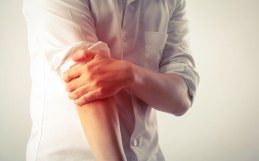You are about to put up a framed picture on the wall. You lift up the hammer, place the nail and, just as you are about to bring the hammer down, you give your thumb a good once over… Ouch!
We’ve all experienced that all-too-common pain as a result of injury or trauma. It’s our body’s way of telling us that something wasn’t a pleasant experience, so try not to do it again!
In this blog, I will explain how the pain mechanism affects our body and what we can learn from the overall pain experience to help us better cope and manage our health
needs.
The Pain Cycle
What is pain? Seems like a silly question. The above scenario — accidently hitting our thumb with a hammer — presents it as a very simple experience.
Yet, from a physiological standpoint, it is more complicated. Mechanical trauma to the thumb will instantly cause localized inflammation. This inflammation will attract ‘mediators’, such as white blood cells or histamines, to the site of impact. Blood will gorge to protect the injured thumb from moving any further and causing more damage. These reactions will cause an immediate swelling, heat and redness in the area.
Substance P is a chemical released through the pain cycle. This substance activates the pain gateway to our brain through receptors located in our peripheral nervous system. The body is now telling our brain, “I am in pain.” To put a stop to this, the pain gateway must be closed.
The Pain Pattern
You all heard the term ‘good pain vs bad pain’. The body only recognizes pain as a ‘bad’ thing — whether it’s physical, mental, emotional or psychological (i.e. grief/bereavement). Understanding how our body recognizes and interprets these pain patterns will allow us to better understand, cope and manage our health conditions.
I usually say to my patients: think of pain as a gauge for how your body responds to treatment options. Except the pain gauge is the opposite of the gas gauge in our car. For a car, more gas indicates we are able travel farther. For our bodies, more pain will limit our ability to move or do things.
When the body heals, our pain pattern will change. The intensity of the original pain will decrease, as well as the frequency of pain throughout the day. With less pain, we will be able to continue in our healing and engage in new activities that were unavailable before. Think of the changing pain levels as markers to healing, similar to the signs along the highway that guide us towards our destination.
How to Take the Good with the Bad
Now that we recognize and understand how our body responds to the various forms of pain, we can take it a step further. Apply different strategies and approaches to help guide your body through healing to a functional state of well-being.

It’s important to note that once the source of pain is addressed, the pain response is the first to diminish and disappear. However, that doesn’t necessarily mean the issue has been completely resolved. Just like a fire that’s been put out, there are still smouldering ashes and embers left over. You need to take care of yourself.
Dealing with the pain is the acute stage of care and it usually lasts 3-6 weeks. Once out of pain, the recovery and restorative stage of care can begin, usually lasting between 6-8 weeks. This is analogous to laying down the foundation for a home, where you can start building the framework. It is here that rehabilitation for the injured area(s) can occur, through various forms of therapy and exercise. The goal is to get the functional range and mobility back in place.
After reassessing individual needs, usually within a 2 month timeframe, a maintenance phase is recommended depending on the person’s unique health requirements to keep the body running smoothly — similar to our vehicle manufacturer’s recommended maintenance schedule. I find that most of my patients reap the majority of their sustained health benefits from a monthly maintenance schedule. This first-hand experience is supported by current evidence-based research on the subject.
As I always say, life is not a spectator sport. Just because we have pain doesn’t mean we have to live with it. There are effective, safe and natural ways to help support the body’s healing and manage the activities of daily living. Take the first step and let us help you get back into the ‘Game of Life’!







